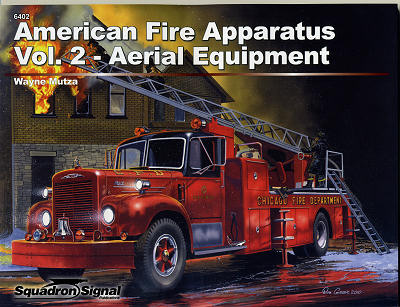Squadron Signal's American Fire Apparatus vol
2 - Aerial Equipment
|
Author: |
Wayne Mutza |
|
Price |
$19.95 MSRP |
|
Reviewer: |
Scott Van Aken
|
|
Notes: |
#6402, ISBN: 978-0-89747-629-4 |
 It is hard to
believe that it has been two years since the first volume in this particular
series, but the wait has been well worth it. How many of us have seen either in
parades or on the television news, the huge 'hook and ladder' trucks? On the
news they are often shown reaching into the upper stories to rescue people or
pouring water on a fire from above.
It is hard to
believe that it has been two years since the first volume in this particular
series, but the wait has been well worth it. How many of us have seen either in
parades or on the television news, the huge 'hook and ladder' trucks? On the
news they are often shown reaching into the upper stories to rescue people or
pouring water on a fire from above.
Derived from the horse drawn wagons that had long hooks for
pulling down burning debris and standard ladders for climbing onto roofs or into
upper story windows, what we now call aerial equipment has been around as long
as other types of fire apparatus. Now not every town has one of these as they
are quite pricey in an already very expensive equipment market. But one is
nearby. In addition to the hook and ladder trucks (which many may recall
were/are so long that they had a steerman in the back to help move these around
tight streets) there are other types that have, for a better term, a 'cherry
picker' type of hydraulic lift and basket. These are in many uses superior to
the standard hook and ladder vehicles, but they do have their limitations.
Provided in the standard 'in action' format, this 96 page
book is absolutely crammed full of color and some black and white photos of
aerial units dating from the time of the Revolutionary War until today. Of
course, most of these vehicles are from the age of motorization and some of the
older vehicles are those that have been lovingly preserved or restored so that
we can view them in their colorful glory. The rest is a wide range of what seems
at time to be a bewildering number of different types and manufacturers. I was
also surprised as to how many rather old systems were moved onto more modern
chassis. This is especially true now when the costs are so astronomical and
departments are stretched in terms of budgets and people.
Author Wayne Mutza provides an introduction to each of the
sections and explains the advances made in equipment as time goes on. It is
generally divided into decades with the important events in apparatus
development explained in the beginning of each decade. But the photos
are the big draw. Each is superbly printed and there are generally four per page, complete with captions explaining the type and some background on the
vehicle shown. Some are a single image on the page and are superbly done.
In all, it is a most enjoyable and fascinating look at aerial
apparatus and how it has evolved from the hand pump units of centuries back to
the modern equipment of today. Highly recommended for readers young and old.
August 2011
My thanks to Squadron Products for providing the review book. Get yours today at your
local shop or on-line retailer.
If you would like your product reviewed fairly and fairly quickly , please contact
me or see other details in the Note to
Contributors.
 It is hard to
believe that it has been two years since the first volume in this particular
series, but the wait has been well worth it. How many of us have seen either in
parades or on the television news, the huge 'hook and ladder' trucks? On the
news they are often shown reaching into the upper stories to rescue people or
pouring water on a fire from above.
It is hard to
believe that it has been two years since the first volume in this particular
series, but the wait has been well worth it. How many of us have seen either in
parades or on the television news, the huge 'hook and ladder' trucks? On the
news they are often shown reaching into the upper stories to rescue people or
pouring water on a fire from above.